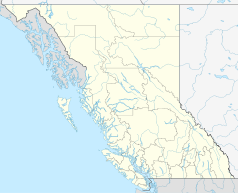Field (British Columbia)
| Field | ||
|---|---|---|
 Train stop in Field, 1935 |
||
| Location in British Columbia | ||
|
|
||
| State : |
|
|
| Province : | British Columbia | |
| Regional District : | Columbia Shuswap | |
| Coordinates : | 51 ° 24 ′ N , 116 ° 29 ′ W | |
| Height : | 1420 m | |
| Area : | 3.53 km² | |
| Residents : | 230 (as of 2016) | |
| Population density : | 65.2 inhabitants / km² | |
| Time zone : | Mountain Time ( UTC − 7 ) | |
Field is a settlement in southeastern British Columbia , Canada . The settlement is located about 17 miles west of Lake Louise , Alberta . Field belongs to the Columbia-Shuswap Regional District and is the last settlement in British Columbia before the Trans-Canada Highway , (here also British Columbia Highway 1 ), crosses the border into Alberta. Golden is about 58 kilometers west of Field .
A local self-government , the settlement does not have, as they are only the status of a community ( community has).
The settlement is considered to be the entrance to Yoho National Park (although it is relatively central in the park) and this is also where the park's visitor center is located.
location
The settlement is not located directly on the Kicking Horse River , which runs in an east-west direction here, as it is separated from this by a railway line of the Canadian Pacific Railway (CPR). On the other side of the river is the Trans-Canada Highway.
The settlement is in the Kicking Horse River Valley. To the north and south the mountains rise steeply and reach heights between 2600 m and 3100 m . To the north are Mount Field and Mount Burgess , while in the south u. a. the Mount Stephen is.
history
Originally the area was settled by the First Nation . Groups of the Secwepemc people lived and still live in the area around today's Fields .
It owes its origins as a settlement for European immigrants to its location at the foot of the Kicking Horse Pass . This pass is the crossing that the Canadian Pacific Railway chose to cross the Rocky Mountains . From 1880 a railway depot was built here, in which additional steam locomotives were stationed for the ascent over the so-called Big Hill and the subsequent spiral tunnels . In 1886 the CPR built a hotel here, the Mount Stephen House . In 1889 the settlement received a post office.
The settlement is named after the American businessman Cyrus West Field .
Demographics
The census in 2016 showed a population of 230 inhabitants for the municipality, after the census in 2011 still showed a population of 169 inhabitants for the municipality. The population has increased by 36.1% compared to the last census in 2011 and is thus above the provincial average with a population increase of 5.6%. In the census period 2006 to 2011, the number of inhabitants in the municipality had decreased by 54.3%, while the provincial average increased by 7.0%.
With an average age of 45.7 years, the population here is significantly older than in the rest of the province, with an average age of 42.3 years. In the 2011 census, Statistics Canada determined the median age . At 36.5 years of age, the population in Field was significantly younger than in the rest of the province, with an average of 41.9 years.
education
Field is part of School District # 6 - Rocky Mountain School District . There is no school in the settlement. The students therefore have to commute to the schools in Golden.
tourism
Field is the starting point for tours to Yoho National Park. It is the starting point for visits
- the Takakkaw Falls (the second highest waterfall in Canada),
- the Twin Falls (the third highest waterfall in the province),
- of the Wapta Falls ,
as well as for
- Emerald Lake (the largest lake in the park),
- the Twin Falls Tee House (a tea house and lookout from 1908) or
- the Burgess shale (one of the world's most important fossil deposits).
Web links
Individual evidence
- ↑ a b Origin Notes and History. Field. GeoBC , accessed December 6, 2013 .
- ^ Census Profile, 2016 Census. Fields Community Profile. In: Statistics Canada . April 14, 2017, accessed June 10, 2017 .
- ↑ Fields Community Profile. Census 2011. Statistics Canada , September 7, 2012, accessed December 6, 2013 .
- ^ School of District # 6. School District # 6, accessed December 6, 2013 .

